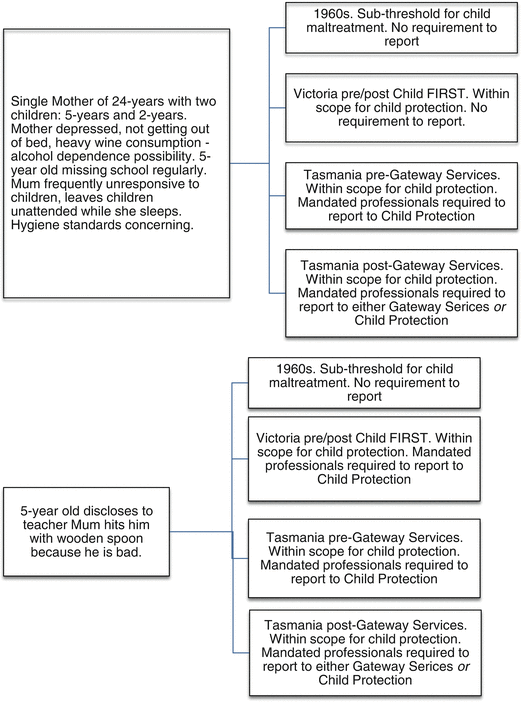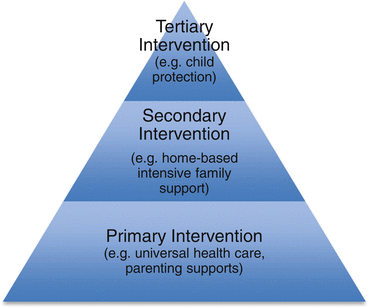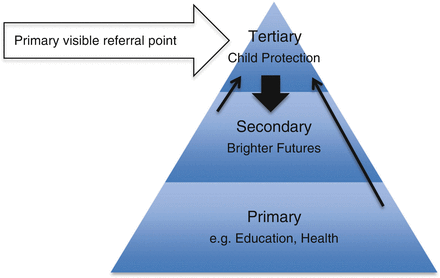The Role of Mandatory Reporting in Preventative Child Welfare Reforms: An Uneasy Fit?

Child in need of protection or “at risk”c
Mandatory reporting requirements
ACT
Physical abuse, sexual abuse, emotional abuse, neglect
Sexual abuse, nonaccidental physical injury
NSW
Physical abuse, sexual abuse, neglect, emotional maltreatment (developmentally or psychologically harmful “domestic environment”)
Physical abuse, sexual abuse, emotional maltreatment, neglect, exposure to domestic violence
NT
Physical abuse, emotional abuse, neglect, sexual abuse, exposure to physical violence
Physical abuse, sexual abuse, emotional abuse, neglect, exposure to physical violence
QLDb
Physical abuse, emotional abuse, neglect, sexual abuse
Physical abuse, sexual abuse, emotional abuse, neglect
SA
Abuse (physical, sexual, emotional), neglect
Physical abuse, sexual abuse, emotional abuse, neglect
Tas
Abuse (physical, sexual, emotional), neglect, exposure to family violence
Abuse (physical, sexual, emotional), neglect, exposure to family violence
VIC
Physical abuse, sexual abuse, emotional maltreatment, neglect
Physical abuse, sexual abuse
WAb, d
Physical abuse, sexual abuse, emotional abuse, neglect
Sexual abuse
In some Australian jurisdictions the broadening scope of what constitutes abuse and neglect is reflected only in the legislative definition of a child in need of protection, which prescribes the conditions under which statutory child protection services are mandated to intervene to protect children from harm. For example, when Western Australia updated their very dated child protection legislation, they changed from a list of specific behaviours (e.g. is ill-treated or suffers injuries apparently resulting from ill-treatment) outlined in 11 separate articles in the Child Welfare Act 1947, s 4(1)(a)-(k) to very broad and inclusive definitions: “the child has suffered, or is likely to suffer, harm as a result of any one or more of the following: physical abuse, sexual abuse, emotional abuse, psychological abuse, neglect” (Children and Community Services Act 2004s 28(2)(c)). They did not introduce any mandatory reporting requirements into legislation at that time. Further, when the Western Australian legislation was amended in 20081 to include mandatory reporting provisions, the mandatory reporting requirements did not mirror the definition of a child in need of protection and instead were restricted only to a reasonable belief that a child had experienced child sexual abuse (Children and Community Services Amendment (Reporting Sexual Abuse of Children) Act 2008, WA).
In comparison, in NSW when the definition of a child in need of protection was expanded to include exposure to domestic violence,2 mandatory reporting requirements were also changed to correspond with this change. One can only assume this was a purposeful decision on the part of the NSW government as there was no legal requirement for mandatory reporting provisions to align with the definition of a child in need of protection. In both states, the broadening of the scope of what constituted child abuse and neglect did not alter the fundamental approach to child welfare, that is, a residual model that relied on suspected maltreatment being detected and reported to child protection services (either voluntarily or under mandatory reporting provisions). In New South Wales, the broadened scope of what constituted maltreatment increased the scope of what was reported to child protection; in Western Australia, only sexual abuse was subject to mandatory reporting laws. In neither State did the new provisions fundamentally change the way in which mandatory reporting schemes work.
The Impacts of Broadening the Scope of Child Abuse and Neglect on the Residual Child Protection System
The residual approach to social welfare originally represented a “good fit” with the understanding of the scope of the problem of child maltreatment. However, child protection systems based upon a residual approach are best suited to problems that are low in prevalence. The increased demand on child protection, particularly attributable to the fundamental change in the scope of what constituted child abuse and neglect, placed increasing demands on what was a crisis response system (Fogarty and Sargeant 1989). Child protection services became subject to increasing criticism regarding their capacity to respond to cases of severe abuse. For example, in Victoria, Australia in 1990, toddler Daniel Valerio was murdered by Paul Aiton who had partnered with Daniel’s mother only 5 months prior to Daniel’s death (Goddard and Liddell 1993, 1995). In the months prior to Daniel’s death, many people, including five doctors, saw evidence of Daniel’s physical abuse including photographs of Daniel with bruising to his face and eyes taken by a police surgeon only days prior to Daniel’s death (Goddard and Liddell 1993, 1995). The heart-wrenching photographs presenting evidence that Daniel was a victim of serious physical abuse combined with the shocking inaction and failure to recognise clear signs of abuse among professionals angered the community and led Justice Cummins (1993) to conclude “There is no doubt, I consider, that if the law in this state was that child abuse be mandatorily reported, this child’s life would have been saved” (p. 741). A concerted community campaign calling for the introduction of mandatory on the basis of Daniel’s case was credited with the introduction of mandatory reporting laws in Victoria in 1993 (Children and Young Persons (Further amendment) Act 1993 Vic). However, others have commented that it was hard to see how mandatory reporting would have changed the outcome in Daniel’s case as Daniel had in fact been the subject of multiple reports to child protection services prior to his death (Goddard and Liddell 1995; Scott and Swain 2002). These commentators instead laid fault on poor decision-making in the context of an underfunded child protection service and a “dual track” system of shared police and child welfare responsibility that had the effect of child protection diverting excess cases to the police for a response (Scott and Swain 2002). It is this author’s position that Daniel’s tragic death was a failure of governments to adequately resource and a failure by those authorities to recognise and respond to serious abuse rather than a failure by the community to detect and report a child at risk to the authorities. While the residual approach to child protection and mandatory reporting were a good fit in terms of their intended function, the residual approach to child protection had become a poor fit for the changed nature and scope of the problem – the failure of child protection authorities to prioritise a clear case of serious physical abuse being symptomatic of an overwhelmed system.
Differential Response
One of the reasons child protection services are overwhelmed is that a large number of the reports of children perceived by members of the community or other professionals as concerning a child at risk of abuse or neglect are subsequently assessed by child protection services as not requiring a statutory child protection response. For example, within Australia, 46 % of reports are investigated and only 19 % of reports are substantiated (AIHW 2013). This leaves a large number of cases in which there are no legislative grounds for intervention, and yet some level of vulnerability, need or risk may have been identified. One of the major strategies implemented from the mid-1990s to better respond to families known to child protection services, but in which children were assessed as not requiring a coercive statutory response, is “differential response” (also referred to as a dual track, multiple track or alternative response; Merkel-Holguin 2005; Schene 2005). Implemented in some form in all Australian jurisdictions, differential response provides a pathway for less severe allegations not requiring an investigation to be referred to voluntary family support services (Bromfield and Higgins 2005a). Differential response essentially comprises the following process: reports received by child protection services are assessed to determine whether a child protection investigation or referral to voluntary family support services is warranted (Connolly 2005). This is presented in Fig. 22.1.
The rationale underpinning differential response: (a) responses to concerns about a child should be commensurate with the level of risk, and (b) non-accusatory assessments and responses to families are typically more effective than adversarial approaches (Merkel-Holguin 2005). In systems in which differential response has been implemented, allegations of serious physical abuse and sexual abuse will still be referred for investigation. However, many of the allegations arising from the broadening of the definition of what constitutes child maltreatment such as chronic neglect are provided an alternate pathway into family support services. Differential response does not represent a fundamental change of approach. Rather, differential response leverages the identification of vulnerable families through the existing residual child protection system with the hope that providing referrals to families not requiring an investigation will divert those families in need into services.
The implementation of a differential response at child protection intake may, therefore, decrease demand for child protection investigations by preventing the escalation of problems and the subsequent re-referral of families to statutory child protection services. However, differential response is not designed to reduce the number of reports to child protection report lines. In fact, it may serve to increase reports to child protection report lines by providing a visible pathway into services for professionals or community members who are concerned about a child. Bromfield et al. (2014) argue that differential response is a sensible reform to child protection services; however, it is still a residual approach and does not include a wider system of targeted early intervention designed to prevent abuse and neglect from occurring. If anything it is likely to increase rather than decrease the vast population of vulnerable children referred to child protection intake services. Within Australia, a groundswell has emerged of academics, child and family advocacy groups along with those government departments responsible for child protection calling for a fundamental change of approach to protecting children: an approach based on prevention and early intervention (Bromfield 2012). Alongside state-based reforms, this culminated in the Council of Australian Governments endorsement in 2009 of the National Framework for Protection Australia’s Children, which explicitly adopted a public health approach to child protection.
The Public Health Approach to Child Protection
Public health approaches, originating from the field of preventable illness, strongly emphasise health promotion and prevention with increasingly intensive interventions targeting identified risks (Baum 1998; Garrison 2005). A public health approach is used when a preventable problem is prevalent and serious and is associated with severe long-term effects on individuals and populations. Public health approaches incorporate a range of strategies determined by the target of intervention efforts and are typically represented as a pyramid and characterised as having three levels of intervention: primary interventions universally available to the whole population, secondary interventions targeted at vulnerable populations and tertiary interventions for populations with indicated problems present. Applied to the issue of child abuse and neglect (represented visually in Fig. 22.2), a public health approach could comprise:


Fig. 22.2
Primary, secondary and tertiary interventions in a public health approach to child protection
Primary intervention: universal services and supports available to all children and families to enhance child well-being (e.g. parenting education, prenatal and postnatal care including home visiting, health care, education, income support)
Secondary intervention: targeted services and supports for vulnerable children and families (e.g. teenage parents) and those with indicated problems (e.g. parental alcoholism), in which children are at risk but parents are willing to voluntarily engage with needed services and supports
Tertiary intervention: statutory child protection services for families in which children are experiencing serious abuse and neglect (e.g. sexual abuse, severe physical abuse, criminal neglect) or in which children’s needs are not being met and parents are unwilling to engage with available services and supports (Arney and Bromfield 2010; Bamblett et al. 2010)3
Under a public health model, there should be sufficient universal interventions for all families. Further, there must be sufficient secondary services available to meet the needs of identified families. Tertiary interventions are framed as an option of last resort. The representation of primary interventions as a pyramid denotes the relative sizes of both the extent of services required to be available and the relative size of the populations to be served by each of the ascending levels of intervention.
Referral Pathways into Prevention and Early Intervention Services
The funding of primary, secondary and tertiary services so that they exist and have adequate capacity to meet demand is a necessary but not a sufficient condition to the successful implementation of a public health approach. The axiom “build it and they will come” does not necessarily translate to vulnerable children and their families. Attention needs to be given to how families can best access and enter available services and supports. A case in point is the funding of the statewide Brighter Futures intensive family support programme as an early intervention strategy in New South Wales (NSW), Australia. Brighter Futures was established in an effort to address demands on the child protection system through intervening earlier. It represented 22 % of the funding ($260 million) in a statewide reform package (Wood 2009). The majority of places in the Brighter Futures programme (80 %) were allocated for referrals from child protection services. The Brighter Futures programme was also able to accept a proportion of self-referrals and referrals from community agencies; however, eligibility for the programme had to be approved by child protection (Wood 2009).
Brighter Futures was a key reform designed to ensure programme capacity existed to provide early intervention (initially targeted at families with young children) for families identified as low risk of child harm under differential response (see Fig. 22.3). This period of time marked unrivalled growth in reports to child protection services in NSW, from approximately 30,000 reports in 1999/2000 to a record high for the nation of 213,686 reports in 2008/2009 (AIHW 2009). A number of factors were attributed to these increases: the establishment of a centralised child protection intake centre (the Helpline) for the state, the expansion of mandatory reporting to include domestic violence, progressive implementation of a $1.2 billion reform package, internal and external scrutiny of child protection and accompanying media attention (Holzer and Bromfield 2008). In 2009, Justice Wood in his Inquiry into Child Protection Services in New South Wales (NSW) found that demand had outstripped capacity and, in particular, that the large volume of reports to the child protection report line had become a bottleneck into the child welfare service system. A critical finding pointing to an unintended consequence of differential response was that while reports were being closed with no action due to a lack of capacity within the statutory child protection services, there was capacity within the Brighter Futures programme to accept a greater proportion of referrals from child protection services (Wood 2009). This represents a tragedy of service system design where the service existed but was inaccessible to families in need due to the inadequacy of the referral pathway into the service.


Fig. 22.3
Intended referral pathways into the Brighter Futures secondary services under a differential response approach in NSW
In the following section, two case examples are presented which describe the introduction of a welfare reform designed to provide an alternate and more direct pathway into secondary services for vulnerable children and their families: one in which mandatory reporting laws were unchanged (Child FIRST, Victoria) and the other in which mandatory reporting laws were amended (Gateway, Tasmania). For each case example, the impetus and objectives for the reforms, the service model and evidence of its effectiveness are presented, and the reforms are then discussed in the context of local mandatory reporting requirements.
An Alternate Pathway into Services for Vulnerable Families: Child FIRST (Victoria)
In 1999–2000, Victoria had the highest number of reports to child protection services of any Australian jurisdiction and was struggling to meet demand (Bromfield 2012). In 2002, the Victorian government undertook extensive data mining of their internal data systems and developed projections based on the current trajectories (Victorian Government Community Care Division 2002). These data trajectories predicted that if nothing were done to reduce demand on Victorian child protection services, within 5 years one in five Victorian children would be reported to child protection services at some stage in their childhood. This statistic was incredibly powerful and was communicated to Treasury, the Premier and Cabinet and other government departments to successfully argue that the approach to child protection at that time was unsustainable (Humphreys et al. 2010). In seeking to adopt an alternative approach, it was recognised that within Victoria there was both a dearth of secondary services with capacity to respond to vulnerable families and that those services that did exist were not well positioned to be visible or accessible within the community (KPMG 2011). As a result, “child protection had inadvertently become the major pathway by which families could gain access to community based [services] and supports” (KPMG 2011, p. 16).
Following extensive planning and a successful pilot (Thomas and Naughton 2005), the Child FIRST and Integrated Family Services welfare reforms were rolled out statewide: Child FIRST being a new referral pathway established as an alternate to child protection and Integrated Family Services describing the array of local service responses. The primary objective of the Child FIRST and Integrated Family Services welfare reforms was to create a visible point of entry into the local service network that would eventually become the first point of contact for individuals concerned about a child, enabling child protection to become a system of last resort (see Fig. 22.4
